West Indies
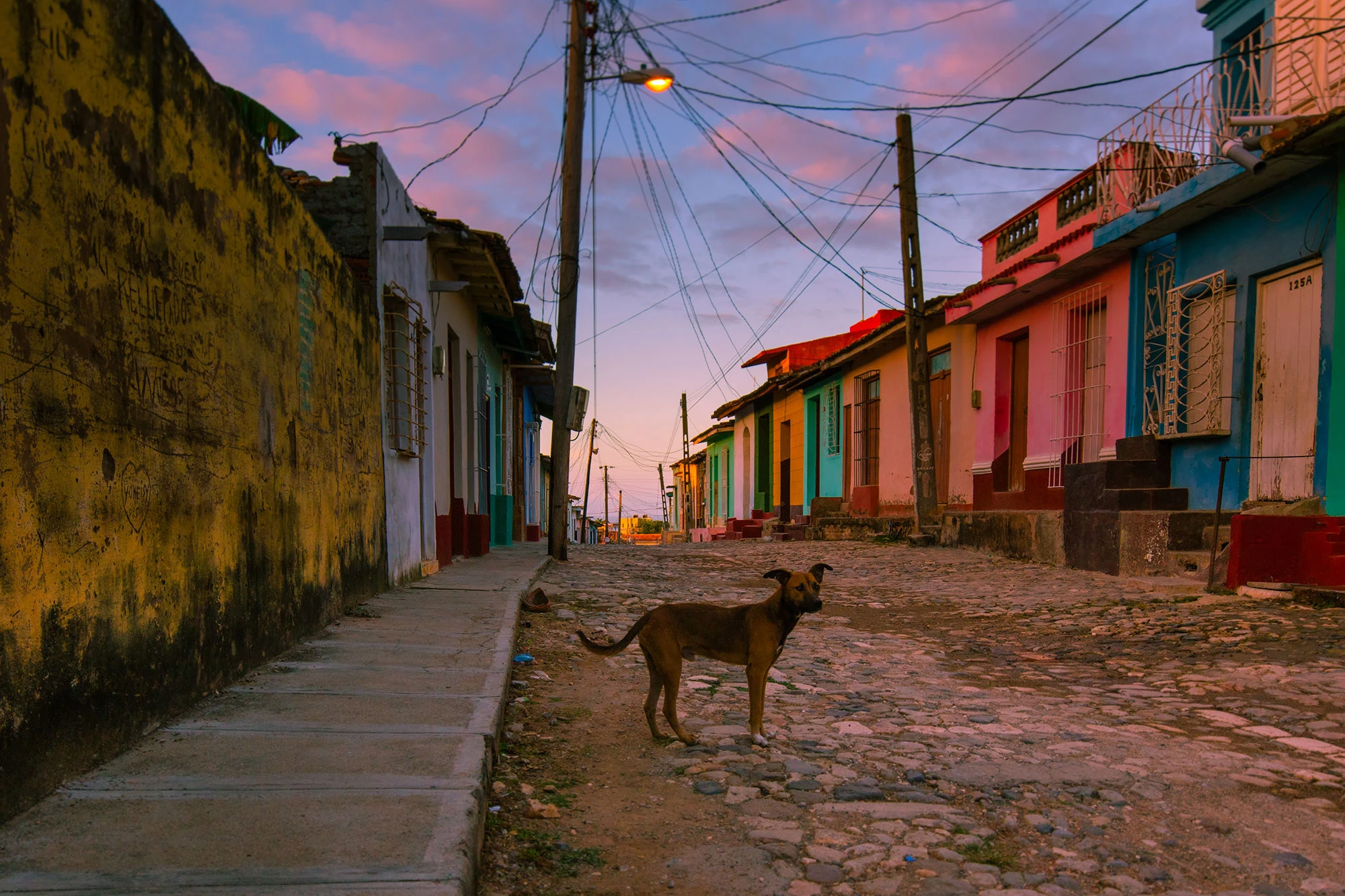
Sancti Spíritus
and the Psychedelic Flyer
My quest to find the Pedorrera bird along Central Cuba's Mangrove Coast
Above: First light on a quiet street in Trinidad, a colonial town in Cuba's Sancti Spiritus province.
These notes continue from Habana Vieja.
S
omewhere on the way from Havana to Trinidad in Central Cuba’s Sancti Spiritus province, the van driver stops at a roadside rest stop, ushering all six of us passengers out into the open sun.
The rest area is thatched with palm fronds, features a full bar, clean bathrooms and a gift shop. Something about the place feels off, as if this well-stocked concession shouldn’t exist in the middle of nowhere.
I decide not to go inside, and rather wait for the others in the sandy parking lot; my chance to look for the pedorrera, the bird that had driven me to Cuba in the first place.
I welcome the hot sun on my face, and I start to see life in the trees. Tawny-shouldered Blackbirds, which exist only in Cuba and Haiti, move through the trees. In the distance, a pack of mean-looking Crested Caracaras tear across an overgrown agrarian landscape.
One of the van riders, a psychiatric researcher from Düsseldorf emerges from the thatched rest stop, commenting on how Germans prefer to stand in the sun.
“Take these,” I tell her, handing over the binoculars, “and look at that bare branch up there.”
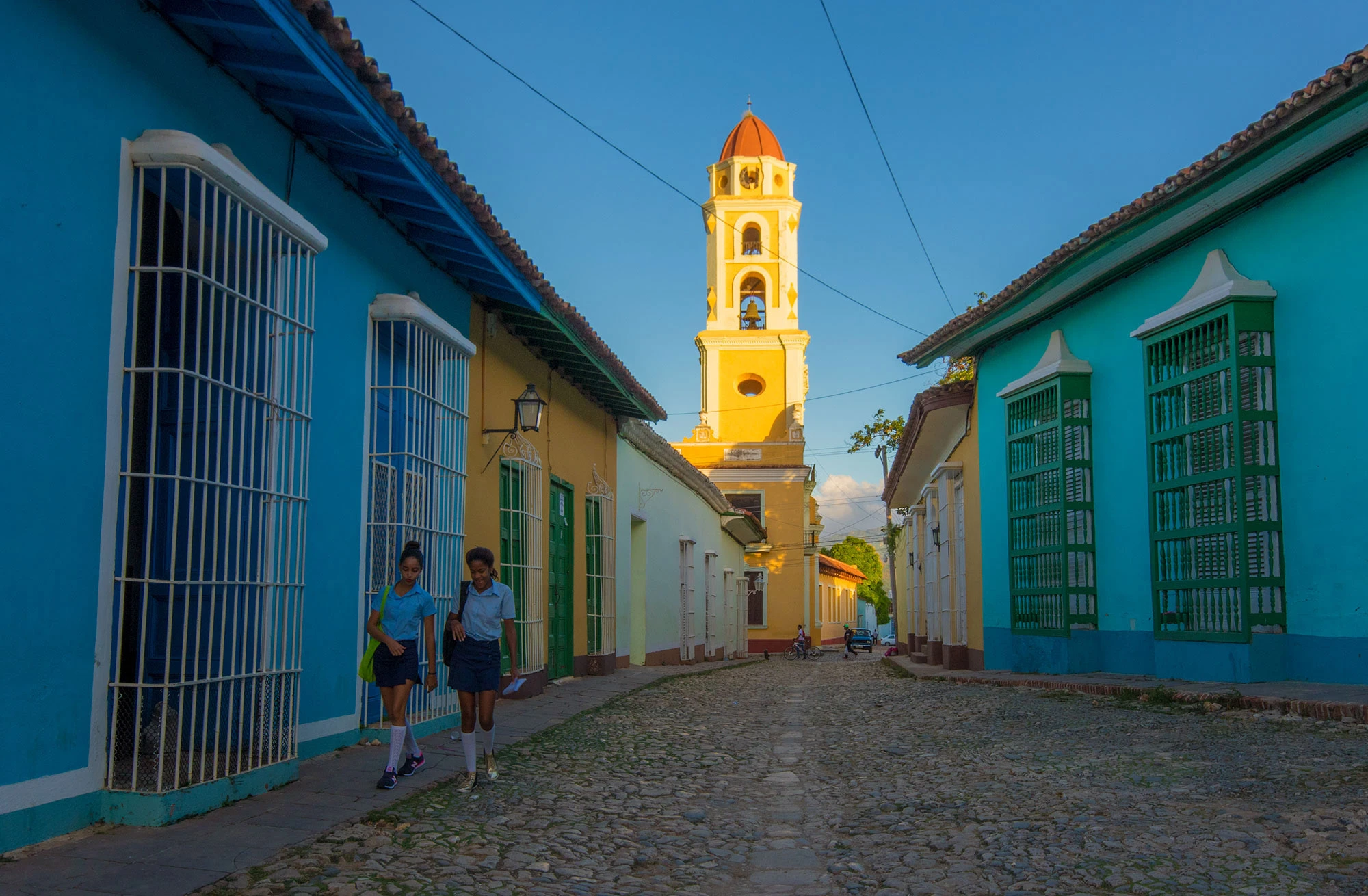
Convento de San Francisco de Asis, Trinidad, Sancti Spiritus Province, Cuba. You can see Trinidad on my watercolor map of Cuba
While she looks up, I comment on my realization that everybody in the van is a solo traveler, a weird revelation for somebody traveling as a U.S. citizen. “But you are female, in your twenties, traveling alone across Cuba?”
“Yes,” she says. “I move faster this way. I experience more when I travel alone. I can wake up in the morning, and tomorrow I might go hiking in the Collantes, or I might go to the plantations. I can’t make that call if I am traveling with a friend.”
“I understand that,” I explain. “But I am curious why our van is all solo travelers, and also, that you seem comfortable traveling alone here? Our government is telling us not to come here. That it is dangerous!”
“We laugh about this,” she says. “In Europe, we know that Cuba is a safe place to travel. But I think it is also a place that attracts travelers who like to travel alone.”
“There it is!” I say. “The Cuban Emerald.”
I explain that I am traveling through Cuba to find another small bird, one that had piqued my imagination since I was a kid. “Actually, the weird thing about this bird is that it’s ancestor’s bones were found in Germany!”
“Let’s check on the others,” I continue, and we find them sitting on benches, waiting in the shade.
“I have a feeling our driver gets a cut from this rest stop,” I say to no one in particular. “But nobody’s buying anything at the gift shop!”
Some laughs, but Sabin, from Southampton, corrects me. “If this were any other country, I would be thinking the same thing. But this rest stop is owned by the government. That’s why it makes no sense that it is here, in the middle of a sugarcane field!”
Sabin is a Samba Reggae percussionist, taking a year off to travel the Americas, occasionally joining up with expositions of Samba Reggae drummers. “It’s really quite odd, isn’t it, to think about this place. A rest stop designed by the government for foreigners.”
Mikolaj, originally from Belchatow, Poland and now an IT specialist in Tel Aviv, raises his finger. “Does a place like this really only cater to non-Cubans?”
Sabin responds; “The Cuban wage is less than thirty dollars a month. Think about that for a second."
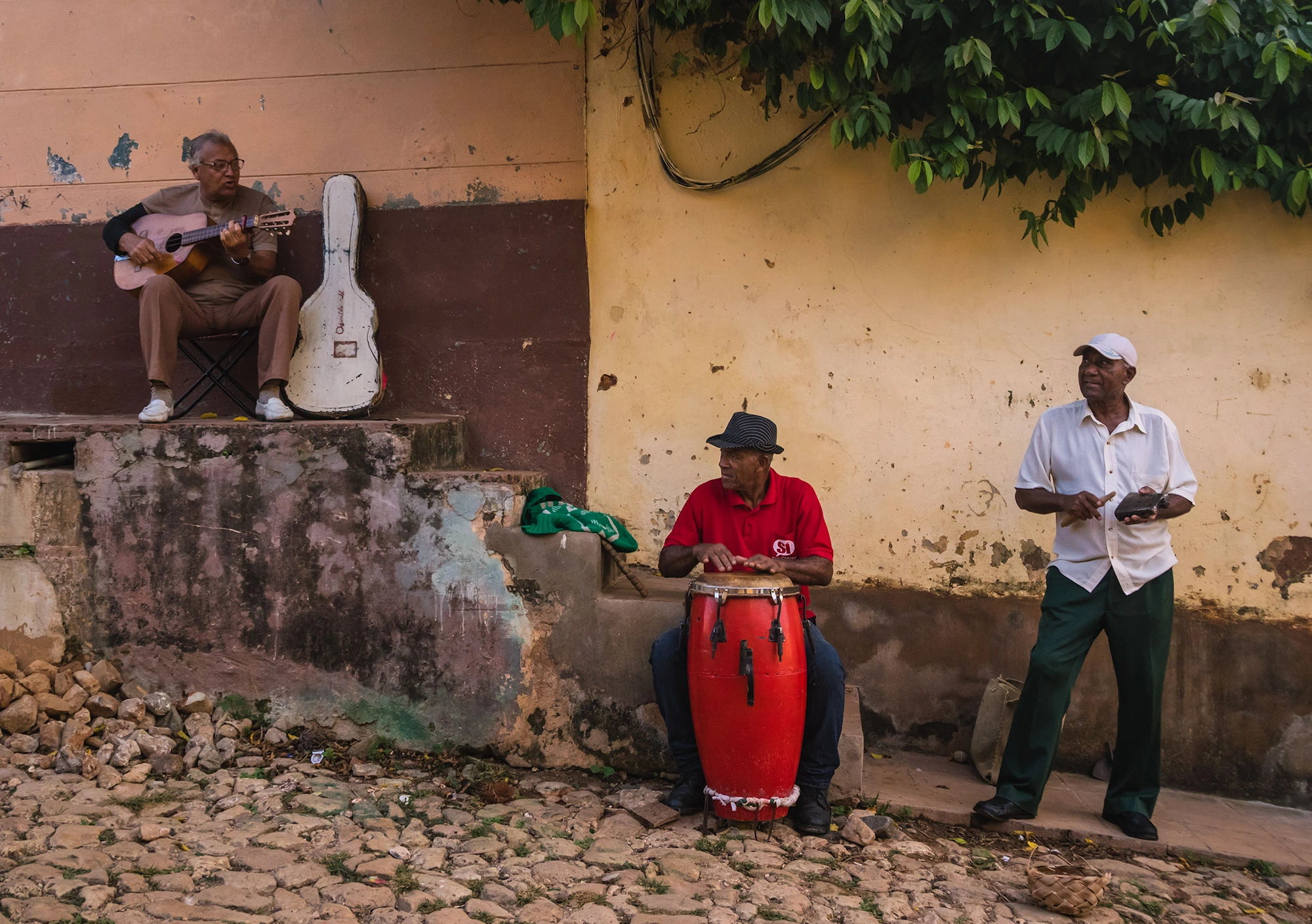
Neighbors play Son Cubano on a typical street in Trinidad.
The shock of the absurdity of these wages is audible, but Sabin continues. “That is the official wage average, but everybody in Cuba has a second job.”
The country had dipped its toes in free-market reforms since the year 2001, but it was not until the year 2010 that Cuba went full hog on granting rights to its citizens to become cuentapropistas - little on-your-own free-marketeers; service-sector entrepreneurs.
When Raúl Castro, Fidel Castro’s brother, assumed power in 2008 and dabbled in loosening the constraints of communism, private industry spread across the country like wildfire in whatever forms it was allowed, and as Obama and Raúl marched toward détente, the entrepreneurial spirit in Cuba grew by the day.
“Families that are doing well in the private sector might earn a thousand or two thousand CUCs a year,” Sabin continues, citing the currency pegged to the U.S. dollar.
When the Trump Administration reversed the right of Americans to travel to Cuba under the People-to-People visa, they forced American tourists to travel in a capacity strictly on air-conditioned tour busses and cruise-ships, damaging America’s burgeoning role in supporting the free market in Cuba.
Americans are actually still visiting Cuba, but the reason that I see very few of them is that they are constrained to tour bus journeys, on itineraries that won’t cross paths with my unconstrained, rule-free itinerary.
Walter, from Valparaiso, Chile adds to the conversation. “You can’t underestimate how important the tourism is. Cuba’s entire economy was based on the fact that it was part of the Soviet empire. When that empire collapsed, Cuba was ravaged. It’s important to understand this, but the 1990’s were not that long ago. When the Soviet Union collapsed, Cuba basically had no gasoline, no energy! Some people say Cuba’s economy declined ninety percent in that decade! The way out was to align themselves with countries in South America, and with China. But those countries are much less reliable now. Their way out was to increase tourism.”
Sabin replies to Walter by saying, “There is something remarkable about how they even survived the nineties. I heard that every day, there are three building collapses in Havana. Just like that...boom! Sometimes people die. But they seem to thrive on almost nothing, despite this crumbling economy. I heard they basically ran out of food in the nineties. But the government did this great job of hiding how bad off the country was, even as they were converting back to mules to sow their fields!”
For the rest of the day, I listen to these travelers exchanging their views about Cuba’s unusual recent history, even while keeping my eye out on the landscape.
Most of the interior of Cuba, at least from the vantage point of this van ride, feels wild, undeveloped. Thick forests and broad meadows are interspersed by sugar cane and mango fields.
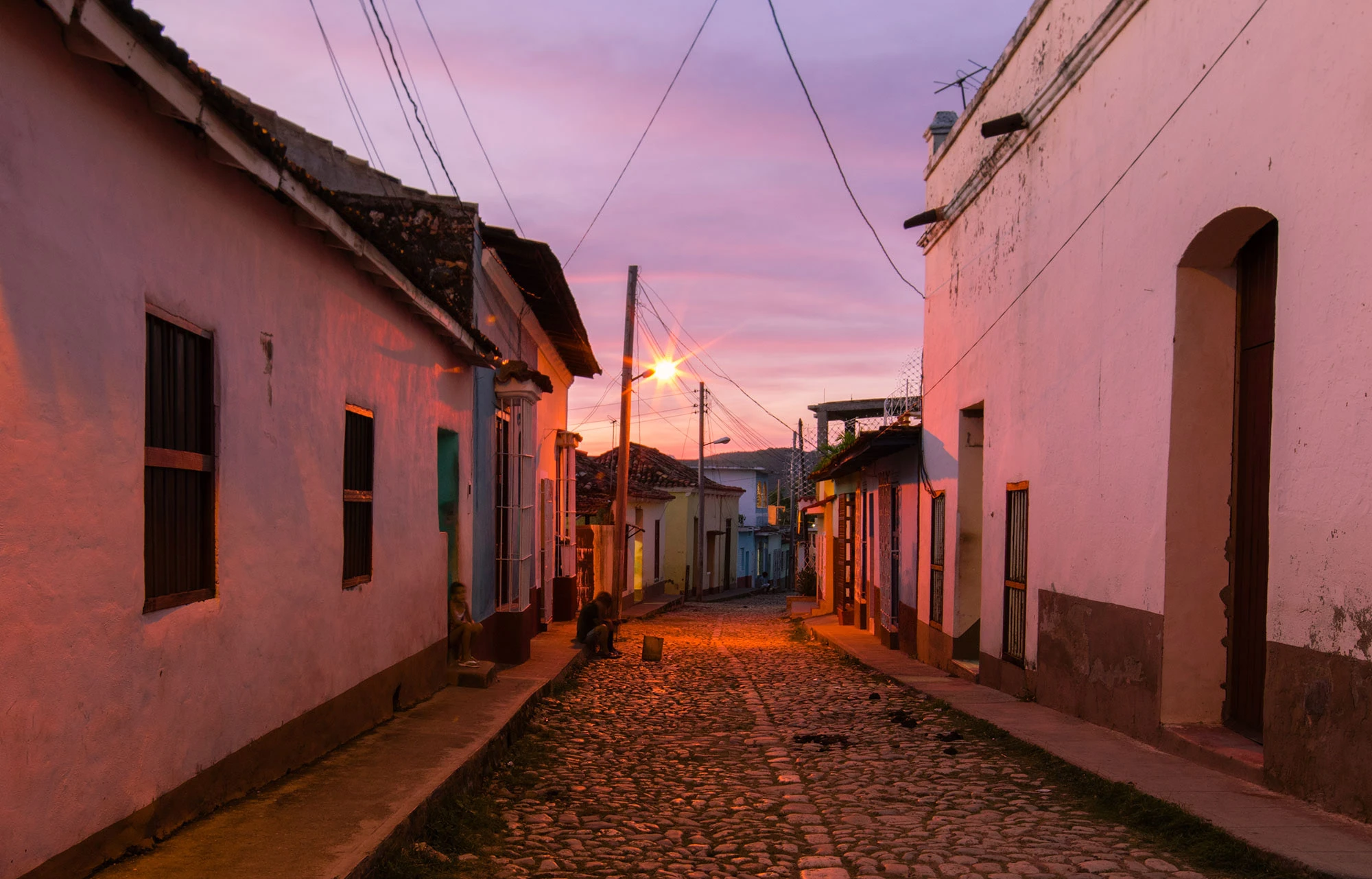
Typical lane in colonial Trinidad.
Cuba has been intensively reforesting since 1998; thirty-percent of the country is now under the cover of trees. Compare that to the year before the revolution, when trees covered only fourteen percent of the country, and to the age immediately prior to European settlement, when trees covered 90 percent of the island.
It’s not that my view out the window is of a pristine and protected land, nor is it an abused and scarred environment. What I think I am seeing is not really a story of a communist government’s failures and successes in protecting its land, so much as the story of the snail’s pace of third-world communist growth and development. It’s the environment of a country that’s been tilled by mules.
The land out here just isn’t needed or desired; the weeds are growing on the backs of a dilapidated economy. Cuba is by far the largest island in the Caribbean, as the country is introduced to the economic engines of the West, and the strains of increased tourism, will deforestation, and similar stresses on the corals and other marine environments begin anew?
And on the other hand, If so much of Cuba’s interior is out of use, how much of it could we imagine being permanently protected into perpetuity?
I say my goodbyes, and jump out of the van. I have dreamed of visiting Trinidad, the pastel-colored UNESCO heritage site and preserved colonial masterpiece of the Caribbean, ever since I first learned about the city in the late 1980s.
One-story houses are painted in yellows and greens, their wrought-iron windows in blues and pinks. Burro wagons struggle up the same ancient and burly cobblestone streets as dirt bikes and antique cars.
I throw my bag down on the bed of my rental apartment, and head out into the city.
Restaurants and cafes are everywhere, but they are buzzing with tourists. I want a quiet place to sit down and sketch in my journal.
Near the Plaza Mayor, I find a restaurant with all its windows open. White-tablecloths and sparkling wine glasses. The restaurant is completely empty.
While I sketch in silence with my watercolor palette balancing delicately on the windowsill, the lone waiter brings me a delicious Pure de Chicharos soup, Lechon Asado, cuban-style sweet potatoes. When I ask for the best rum, the kitchen is concerned that I ordered something too expensive, and the sommelier comes out to show me the bottle. After this pleasant meal, with room to paint quietly, my bill stuns me. Sixteen CUCs, equivalent to sixteen U.S. dollars, less than a rushed breakfast at a coffee shop in Portland.
After dinner, I continue to sketch in a quiet public space near the restaurant, which features a handful of trees and a few public benches. The act of sketching, to me, a solitary and personal act, sometimes gets casual onlookers.
Some Cuban couples, on vacation themselves, and even some families, approach me, asking questions while looking over my shoulder. One couple, celebrating an anniversary, and visiting Trinidad from nearby Cienfuegos, asked in English about my watercolor palette, and then about where in the United States I came from, and then of course they asked for me to explain the Trump Administration.
I had already been asked about this several times in Cuba, and I wasn’t pleased with the way I had been explaining it, so I had a story on the tip of my tongue for the next time someone asked.
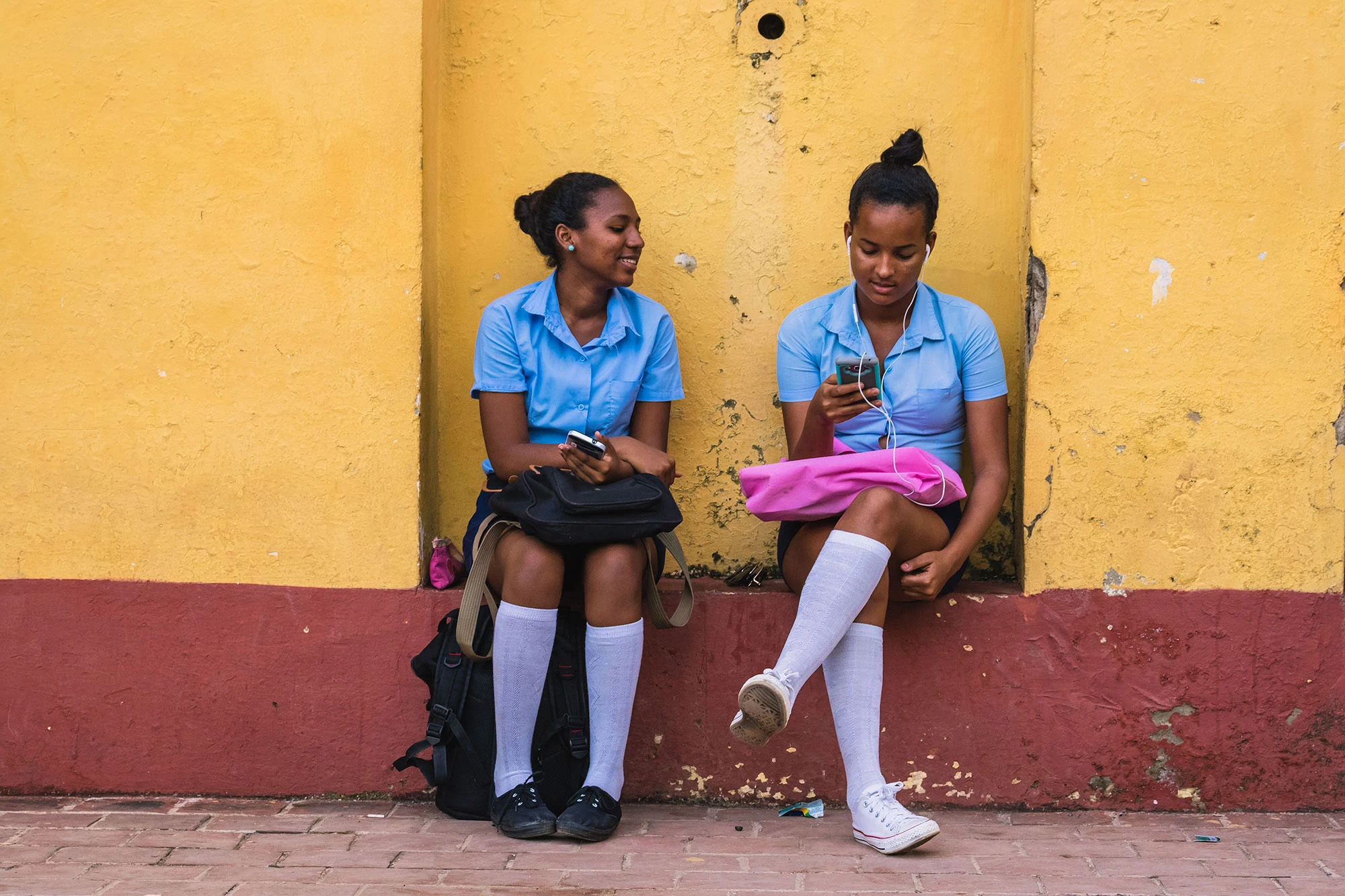
Accessing government-sponsored internet at a public wi-fi spot. Cuba has been rightly criticized for censorship crimes in Cuba, but young Cubans have access to the world beyond their island through interaction with foreigners, television, and access to the internet.
“When I was growing up,” I explain, “in the 1980s, we could really feel the Cold War, and we were really fearful of it. There were these air-raid sirens in my home town that were used for both tornado warnings and nuclear war warnings, and they just creeped me out! They literally gave me nightmares! So when this movie, Red Dawn came out, which was about war actually breaking out, lo and behold, who is depicted as being as attacking the United States?”
I describe a cigar-smoking Cuban general, and the husband and wife begin to laugh at this.
“The problem is,” I explain, “The United States is still partially living that movie. We’re still stuck in the cold war.”
Ancon Peninsula
In the morning, I hail a taxi and ask him to take me to the coast.
“No, don’t drop me off at the resorts,” I explain. I am trying to get to the mangrove lagoons.
The taxi driver is confused. There is nothing after the resorts except for a dirt road.
“Yes!” I say, pointing to a road beyond the end of the strip of resort hotels. “Go that way!”
The taxi driver continues, but the road stops.
“Left!” I say, as right appears to head back to the resorts.
The taxi crawls past a gate and its security guard. “Este Americano está tratando de llegar a las lagunas” the taxi driver explains to the security guard.
They are still talking while I pay the driver and close the door. I know from Google Earth that there are saltwater lagoons hidden behind the long peninsula that extends out east from the Playa Ancon area.
I can tell that I am inside some kind of gated marina area. What I can’t tell is how to get out of it from here. I hug the interior side of the marina property, looking for an exit into the lagoons.
The problem is, the security guard is following me.
My plan is to keep walking until I am off this property, maybe even slipping into the mangroves before the guard can catch up with me. But it’s just a matter of time, he is right next to me.
“I am sorry, senior, this is puerto deportivo exclusivo. You must leave.”
“I am just trying to get to the lagoons,” I explain.
“You must go to the playa!” he explains.
I show him my map. “I am trying to get to this point, here!” I say.
“Playa!” he says.
“But I will be off this property in no time!” I explain.
“Playa!” he says.
Crap, I give in. By playa, he says I need to go to the all-inclusive resorts, just a short walk away from here.
By this time, the sun is already baking hot, and I now realize I need to resupply my water bottle. I might as well fill up at one of the resorts.
I walk into a large resort building. It’s painted in bright colors, but there is something worn, dated and Soviet constructivist about the building. It immediately creeps me out from the outside, but the inside is downright lurid.
Beachside resorts, even the worst of them, typically have cheery interiors, with lots of light that brings the warmth of the holiday sun indoors. Not this place. Despite its bright primary colors, it feels cavernous and damp on the inside.
There is a small kiosk fixing espressos for the guests, so I ask the barista if he has water for my water bottle. He tells me to go downstairs to the gift shop, where they should be selling water.
But the basement lights are all off, and the gift shop is closed, and so I start asking every employee where I can buy some water or just fill up my water bottle. The bar doesn’t have water, the breakfast cafe doesn’t have water, and the concierge can’t explain where else I can get water.
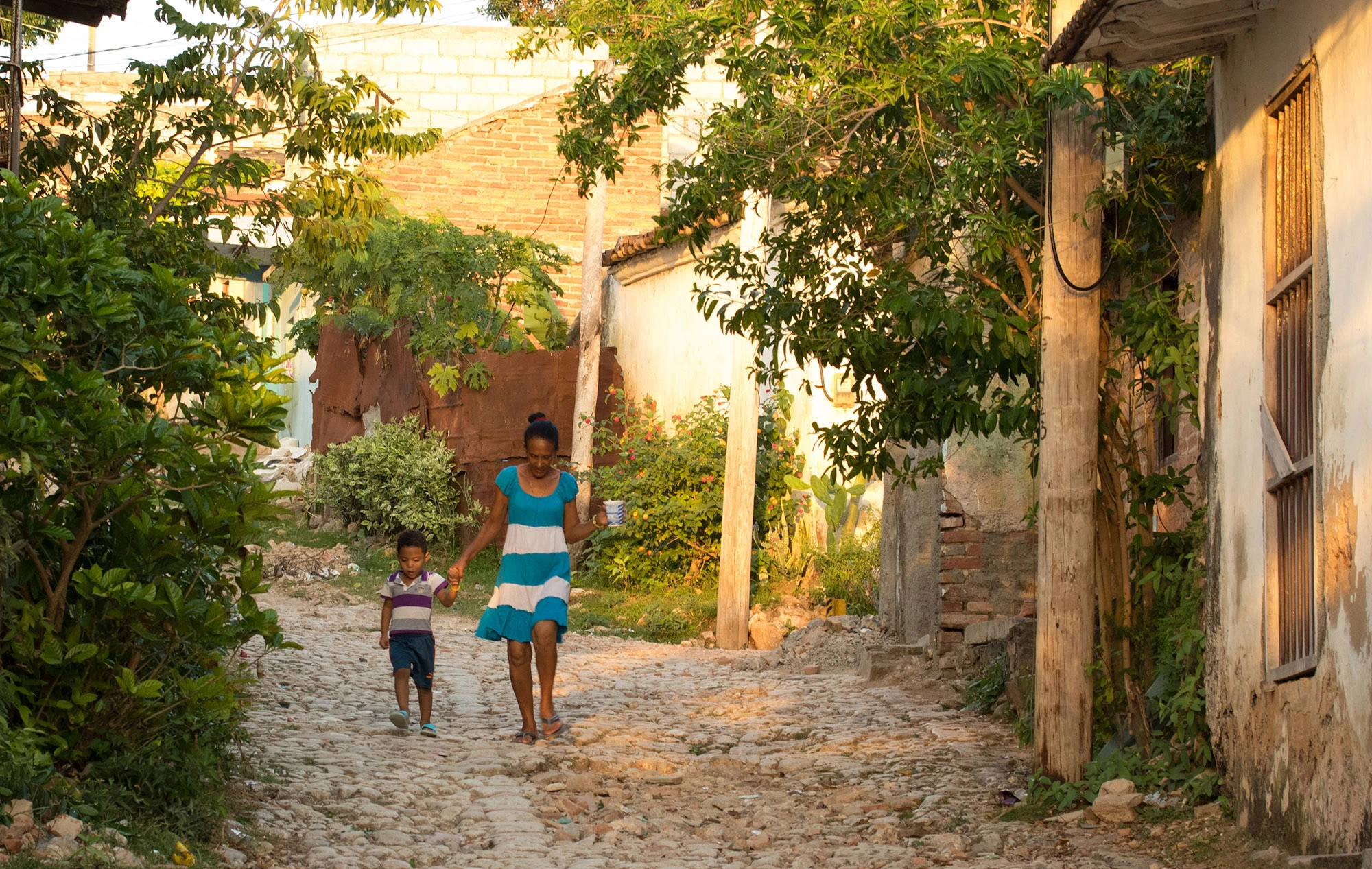
Boy and grandmother in the outer reaches of Colonial Trinidad.
I decide to sit down at the kiosk and order an espresso, and hope that time will resolve my water crisis. It’s already getting hot out there, walking towards the lagoons would be ill-advised.
A coterie of women in their late fifties breeze up to the kiosk. They are wearing red reindeer antlers and speaking in Dutch, twirling about as if drunk. It’s eight-thirty in the morning. What’s in store for the rest of their day?
I have seen these types of beachside hotels before. They are the prize you win when you get second place on The Price is Right. They are where workaholics go on a vacation. But there is nothing to do at these places, and nowhere to go. The beach is narrow and unimpressive, the lounge chairs out front are packed together, and there is no water!
I decide to try to walk toward the lagoons, just to see if I can access them from the beach, and then return back to the hotel with the hopes that the gift shop will be open.
I haven’t had a sip of water since yesterday, so I will just try to conserve energy and move slowly. I walk a quarter mile down the beach, and I soon notice that all the human footprints disappear, even above high tide line. What that means is that although there is an enormous string of hotels just behind me, not a single footprint is visible only a quarter mile away from them.
But if you look at this area on a satellite map, the area beyond the hotels is certainly one of the most visually compelling geographic areas in all of Cuba.
I’ll turn back as soon as I find access to the lagoons and mangroves, I tell myself, feeling the heat. I crawl off the beach through some scrub, and am surprised to find a motorcycle trail cutting through the scrub. Damn, that security guard was trying to tell me where to go.
I should turn back now, I say. On the other hand, on hot, languid days, birds will often disappear by mid-morning. Finding the wild interior of this place is going to be my last chance to find the pedorrera.
I decide to keep going, pacing myself, and reminding myself to turn back before the heat starts to get to me. I gather that this motorcycle track probably gives fishermen a variety of access points to crab traps or fishing spots.
As I plod along, this marine forest begins to explode with life. Zebra Longwing butterflies, brilliantly-colored orbweaver spiders, a shy mongoose, slinking along in the undercover.
While I love the mangrove forest itself, for all its strange mystery and life, there is always a buffer zone forest of trees that only grow at the edges of mangroves. Trees with lovely names like Sea Hibiscus and Sea Olive lean in to the motorcycle path, lending shade.
I am lured through the forest by the anole lizards that hide in these trees and the ones that scurry under them. On Abaco, where I spent many months of my life enjoying the wildlife of the mangroves, there are only two species of these Caribbean lizards, but in Cuba, there are over 65.
And there are birds too. Osprey, Loggerhead Kingbirds, Cuban Vireos, Cuban Pewees, Nashville Warblers, Blue-gray Gnatcatchers. Still, no sign of the pedorrera.
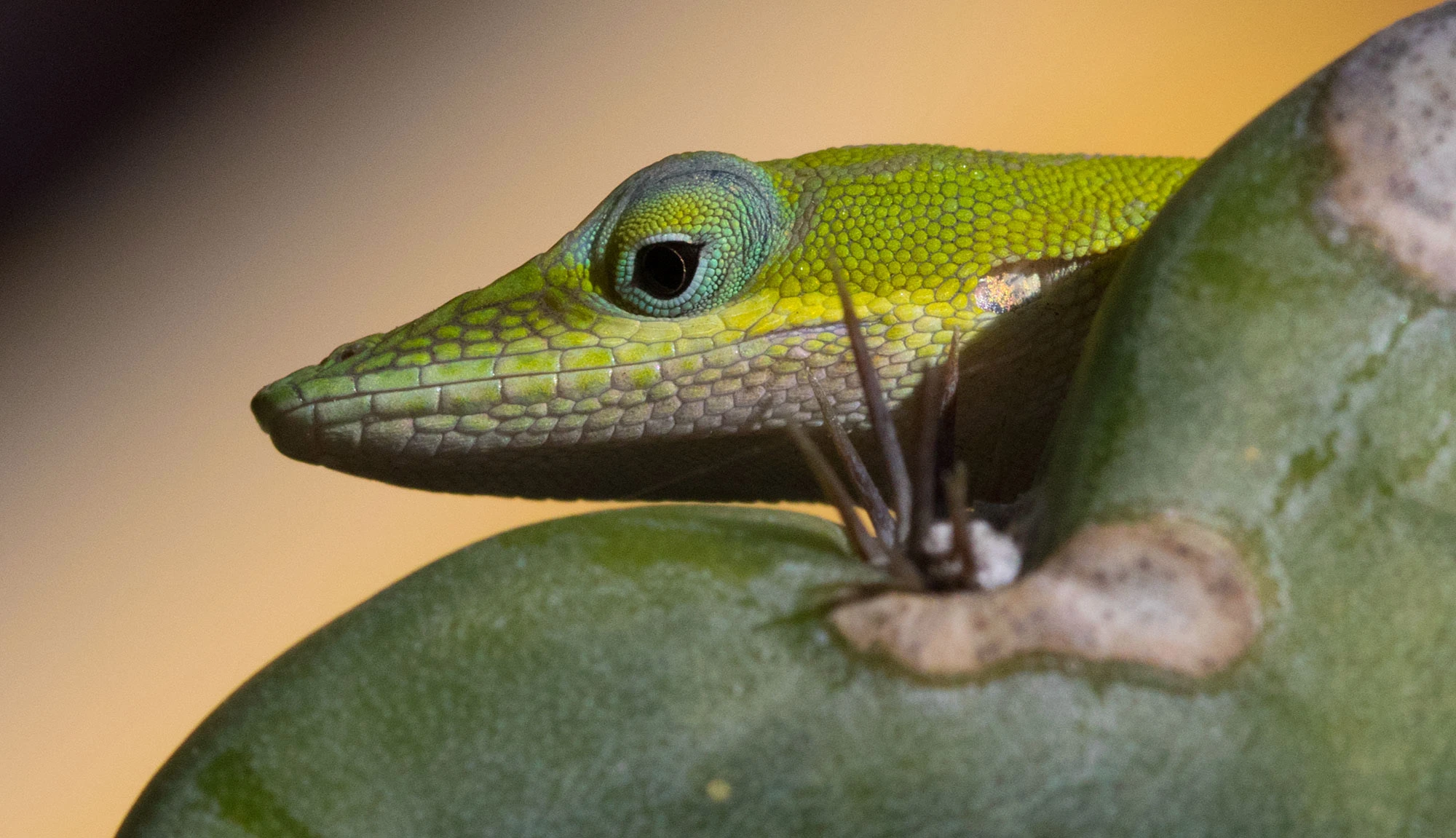
Juvenile anole on a cactus between the communist Playa Ancon all-inclusives, and the Playa de la Personas peninsula.
Some aspects of the habitat have me encouraged, however. Pedorreras, or, as we call them, Cuban Todies, are habitat generalists, which means they pretty much live anywhere.
The thick vegetation along this mangrove forest is a good habitat match for this species. Small technicolor birds often rely on dense foliage to disappear from predators, and this habitat certainly has plenty of that.
There are five species of todies, but all of them are constrained to the islands of the Greater Antilles in the Caribbean.
One of the key features of all todies is their enormous heads, giving them a cartoonish, surreal quality. What other birds look like that? The todies actually resemble those big-headed Kingfishers, and other old world species like the bee-eaters of Asia and Africa.
This is not a coincidence, as the todies are actually closely related to the kingfishers.
Frauenweiler, a small town just south of Heidelberg, Germany, is known for its clay pits which have produced many great fossil species, especially of fish from the oligocene era, about thirty million years ago.
At the start of this epoch, the ocean had found its way deep into Europe, and Southern Germany hosted tropical beaches replete with bizarre, giant mammals.
In the 1980’s, paleontologists uncovered and described the bones of todies, as well as hummingbirds, in the same clay pits that produced the fish.
Although the bones were of a larger tody than what exists today, the bones are remarkably similar. A direct ancestor.
It’s easy to see this tiny bird as some sort of pioneer from South America, the continent that produces so many wildly-colored birds, but back then, South America was cut off from the rest of the world; a floating laboratory of weird life. Back then, South America was producing giant, carnivorous terror birds, not delicate, tiny kingfishers.
But North America was connected at the time to the old world, and todies, like hummingbirds, were common across Europe, North America and likely Asia as well.
While little is known about the origin of the todies, they are remarkable to me as some holdover from a distant epoch, siloed by time and fate to a sliver of the New World.
I continue walking along the motorcycle trail, forgetting that I am now some two miles away from the resorts. The path spills out onto the ocean at the tip of the peninsula. There is not much of a sand beach here, just mangrove and a thick paste of leaves, forming a mucky transition between land and water.
I’m now in the hot sun again, but I want to see if I can follow the coastline around the bend of mangroves and into the lagoons. Maybe I can then cut back diagonally towards the motorcycle trail. I am almost certain that in such a pristine environment, there must be a tody or two!
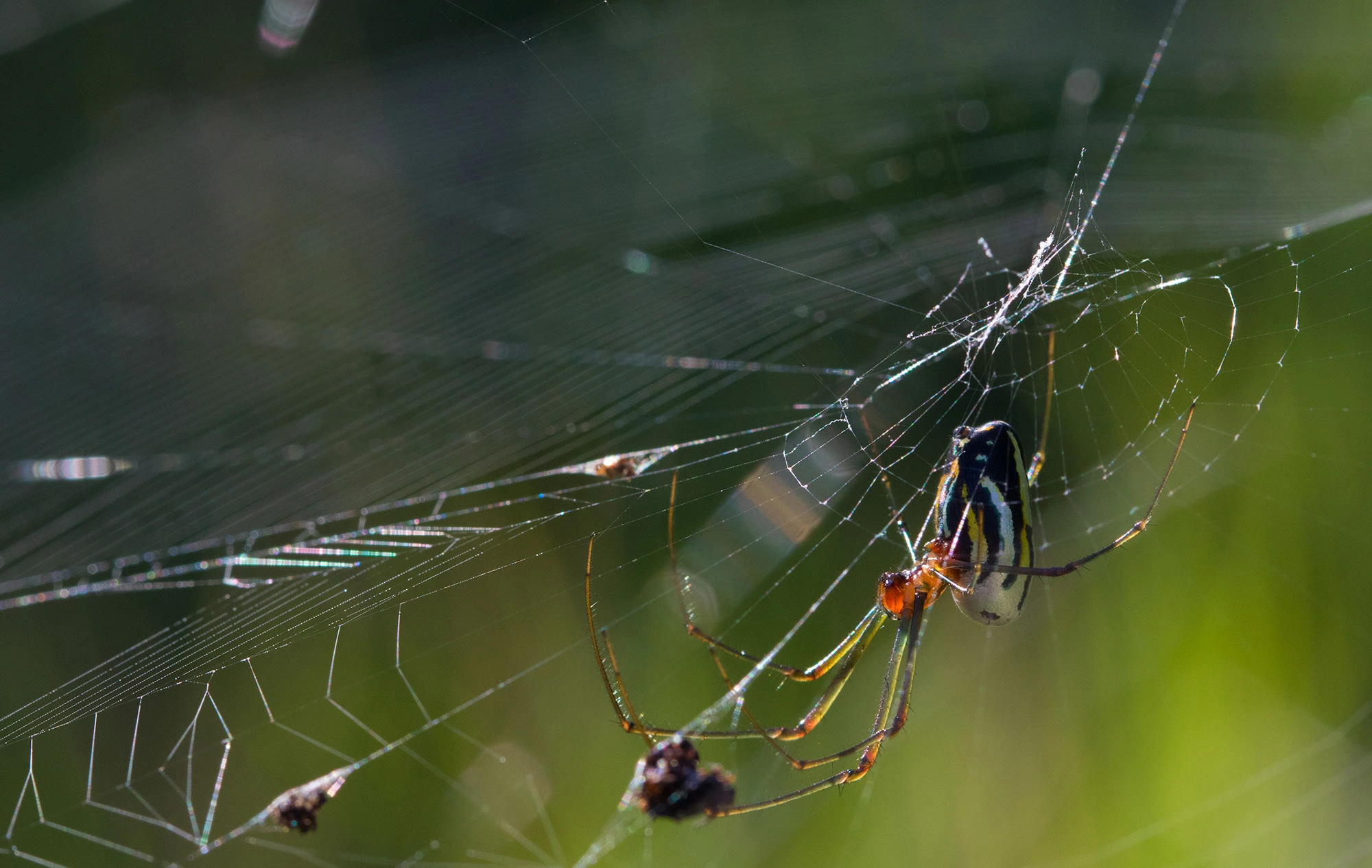
Orbweaver species on the Playa Ancon Peninsula in Sancti Spiritus province.
I have forgotten completely about my thirst, and I start trudging through the leaf muck, imagining that perhaps the inside of the peninsula has a narrow beach to walk on.
Slowly, I make it around the bend, sometimes getting on all fours to distribute my weight across the leafy muck. When I make it to the inside of the peninsula, I see that there is no beach. And this spare mangrove habitat is no tody habitat.
This is the point where I give up on the tody. Traveling in pursuit of birds is not really about the birds, anyway, it’s about everything that happens in between. I may have never found the pedorrera, but would I really have explored all these places if I wasn’t looking for it? Would I have seen my first mongoose and my first Cuban Twig Anole?
When I return to the resorts, I find a beach bar has opened. I am shaking with thirst, and cannot help but order myself three orange sodas. I consume them instantly, one after another. I then fill up my water bottle with water from the bar. I feel charged up and ready to go.
I find my way to the porte-cochère of the nearest resort, and ask the valet if he would help me with a cab. He immediately whistles, and a 1940’s red Buick comes crawling towards us from a nearby street.
“Where did he come from?” I ask, incredulous. “You are in Cuba, my friend. The one thing that is always true in Cuba is that there is a taxi!”
“I have a favor,” I ask. “My Spanish is not so good. Can you tell my taxi driver that I will compensate him for stopping every time I ask, and to just go along with whatever I ask?”
The valet gives me a look, and then has a somewhat long-ish conversation with the taxi driver. They both look at me, and then, “Sure thing, amigo!”
This is my first ride in an antique American car, and it’s true what they say about them. While the exterior looks to be in good shape, you cannot avoid the fact that the car itself is seventy-two years old. The interior reminds me of the worn, oily feel of old tractors stowed away in dark barns.
I smile at my taxi driver and shake his hand. As a taxi driver, Gimoaldo is also a full-time mechanic. He knows the ins and outs of his steed, and knows how to replace and repair every part. Spending time under the chassis is just a part of his life.
We drive off towards Trinidad. I explain to him that I had seen some interesting habitat, and even some birds, between here and Trinidad. Maybe we can stop and look around there?
“Here, here! This is it!” I say. Gimoaldo pulls over and I jump out, hiding myself behind some bushes that hang over a strip of brackish water.
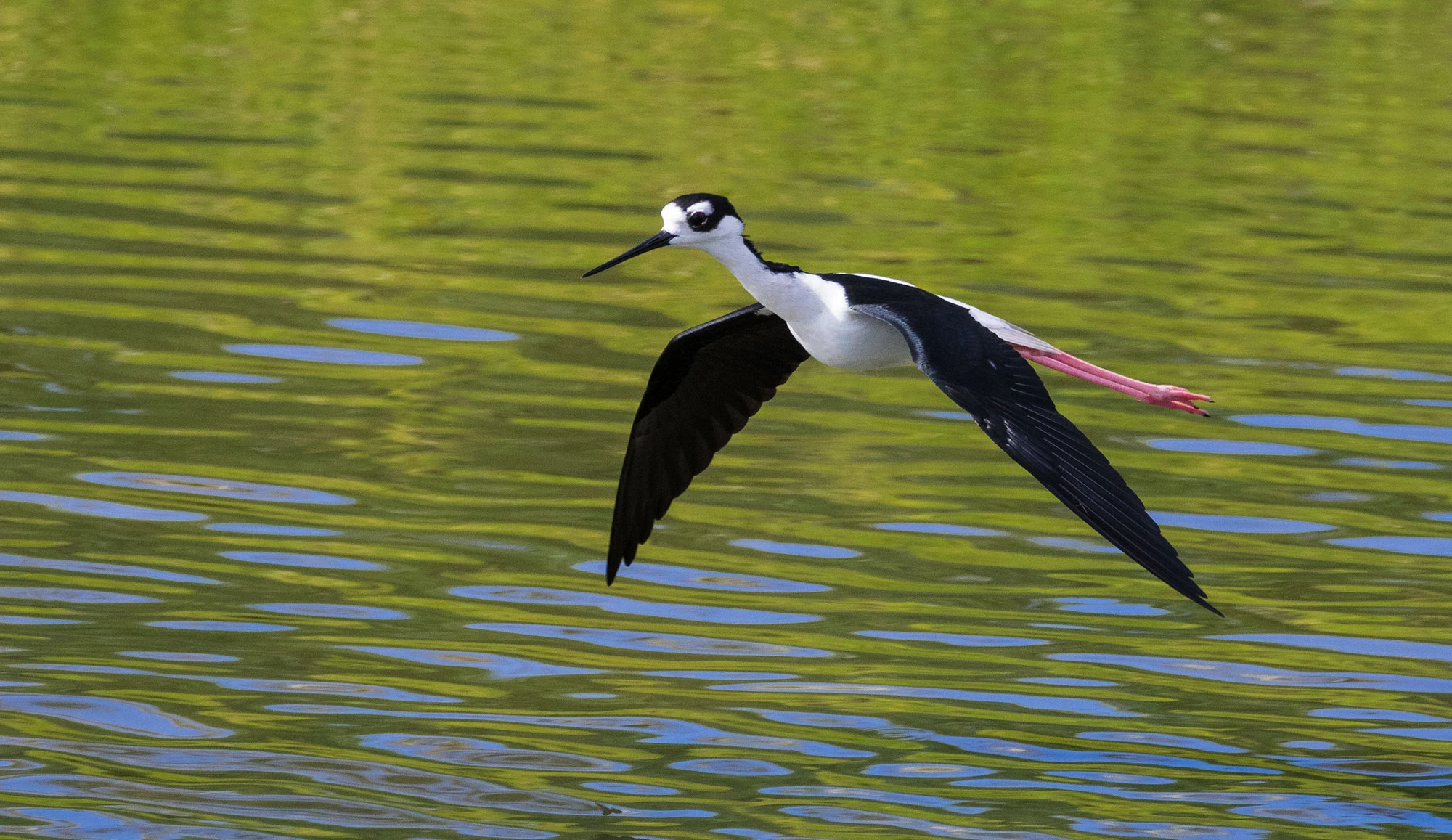
Black-necked Stilt in flight over the tidal marshes near Playa Ancon.
“Gimoaldo!” I yell. “Get over here!”
The taxi driver cautiously gets out of his Buick, crouching down beside me. Our view is of thirty of forty Black-legged Stilts, maybe the most elegantly shaped avians on Earth.
Gimoaldo drives this road every day, but I wonder if this is the first time he has actually seen these stilts. “Bueno!” he says, smiling. And then he points out other wading birds.
We continue on, making a handful of stops. “Gimoaldo, what if we don’t go back to Trinidad yet. What if we just kept driving?”
He describes the areas around Trinidad, and suggests that maybe his Buick won’t have the easiest time getting up into the Collantes Mountains. Instead, we decide to head to nearby Parque el Cubano, a watery jungle at the base of the mountains.
The buick plods along a rough, rocky road. We stop along the way, as Gimoaldo offers up the Cuban names for each bird we see along the way.
At one point, I walk off into the woods, and when I come back, a young wide-eyed Arabic man is standing next to the taxi driver. Gimoaldo explains that this man had hiked here from Trinidad, and is looking for a way to get back.
I explain that I had already made arrangements with the taxi driver for the entire day, so he was welcome to join us as long as it was okay with both of them.
Everybody agrees and the young man jumps in the back of the Buick. “I will help with the taxi fee,” the man says, and introduces himself as Ali, a Moroccan who was working as a physical therapist in Brussels.
“I am taking a gap year,” he explains, naming the countries he has visited.
“Where will you visit in the states?” I ask, assuming a flight to Miami is a part of his itinerary.
He looks at me. “No way, man! Look at me, I am a Moroccan man in my twenties. My friends have told me stories about being stuck at airport security for three hours of questions. Missing their flights! I would like to go someday, but now is not the time.”
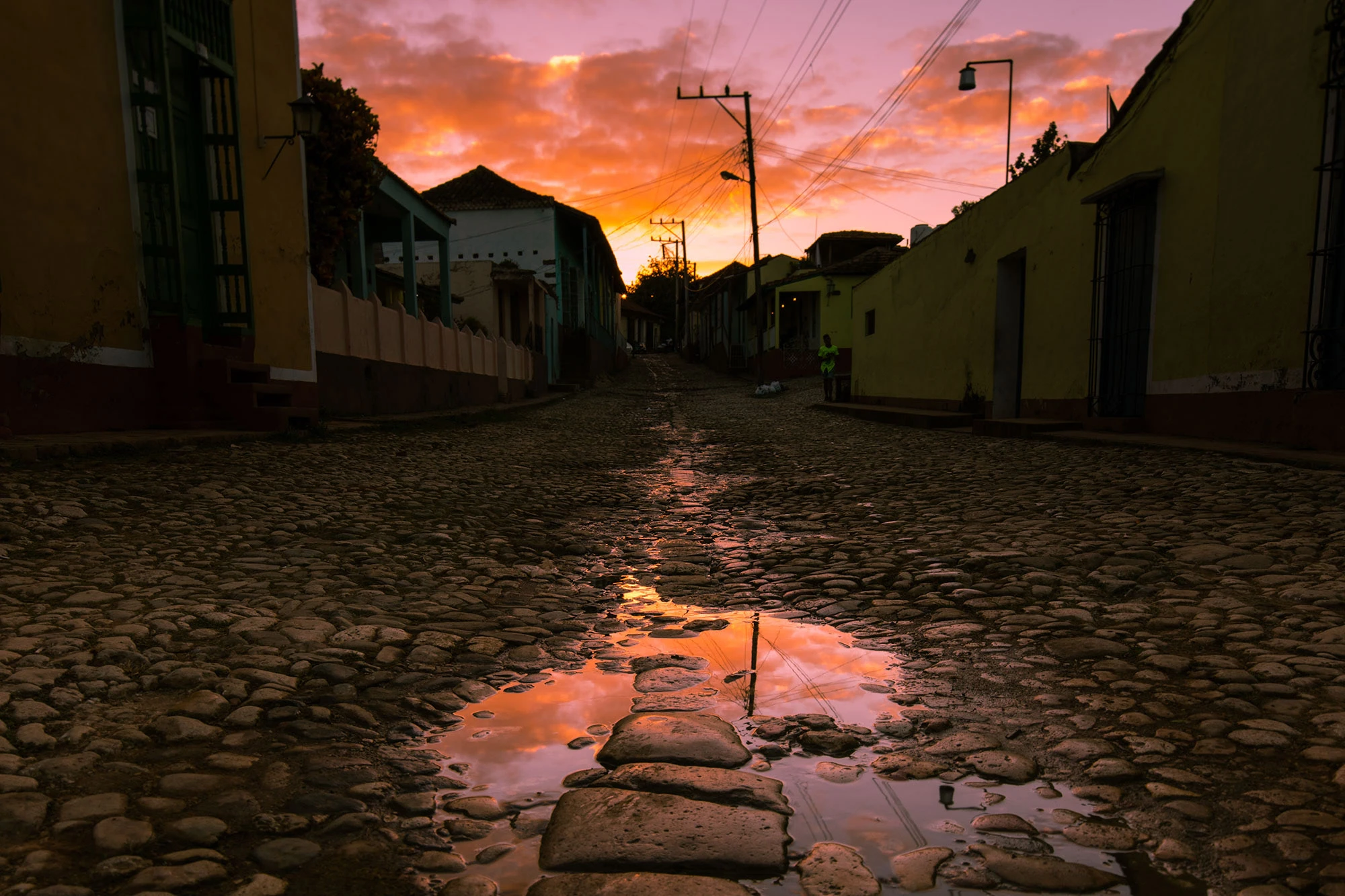
Early morning in Trinidad, Sancti Spiritus province, Cuba.
I explain to him that when he does come to the states, he should just visit the West Coast, and try to avoid the east coast airports altogether. “You’ll still get lots of questions, but it will be more bearable. I bet you could fly into Vancouver. Once you are there, you can get anywhere along the West Coast in a short flight.”
I explain to him the events that unfolded in Portland this year, how a homeless Trump supporter was yelling at two Portland women who were wearing Muslim headscarves, screaming racist remarks. I explained how behavior like this was beyond unusual in the cities of the West Coast, but that it had started to become more common after the election of the new president.
“The point of the story,” I explain, is that three men got up from their seats on the train to try to stop the man from harassing these young women. But he then attacked them, killing two of them. We knew several people who were friends with these men, so it was a really sad time in Portland. But that’s what you have to understand. We believe strongly in tolerance. We’ll fight for everybody. There’s nothing we can do about that airport security, though!”
The Buick makes its way along the rocky road, as Ali shares stories of traveling around Latin America. “I really liked the Costa Ricans, they were the most tolerant.”
“It’s funny, but I keep thinking about Costa Rica,” I say, “while I am in Cuba.”
“Yes, I can understand that,” Ali explains. “They are very similar in some ways, especially because of the health care. Costa Rica got rid of its army and invested heavily in healthcare.”
“Except, what’s the difference?” I say. “Costa Rica is the happiest country in North America, and Cuba is the poorest.”
“The difference is Castro,” Ali says.
“Of course,” I say, “but I think as an American it’s important for me to not always blame Castro for the poverty of Cuba. We created Castro. Florida golf developers and New York mobsters created Castro. The Cold War created Castro. We created the communist mess in Cuba."
"America created Castro because you created Batista," Ali replies, referring to the American-supported dictator who preceded Castro.
"Right, Castro was just the result of that. We set it all in motion. A certain type of tourist investment set it into motion."
“I am not sure Cuba can be a strict nature destination, like Costa Rica,” Ali says, thinking about it. “But it doesn’t need to be. It has arts and architecture. It could be the urban Costa Rica.”
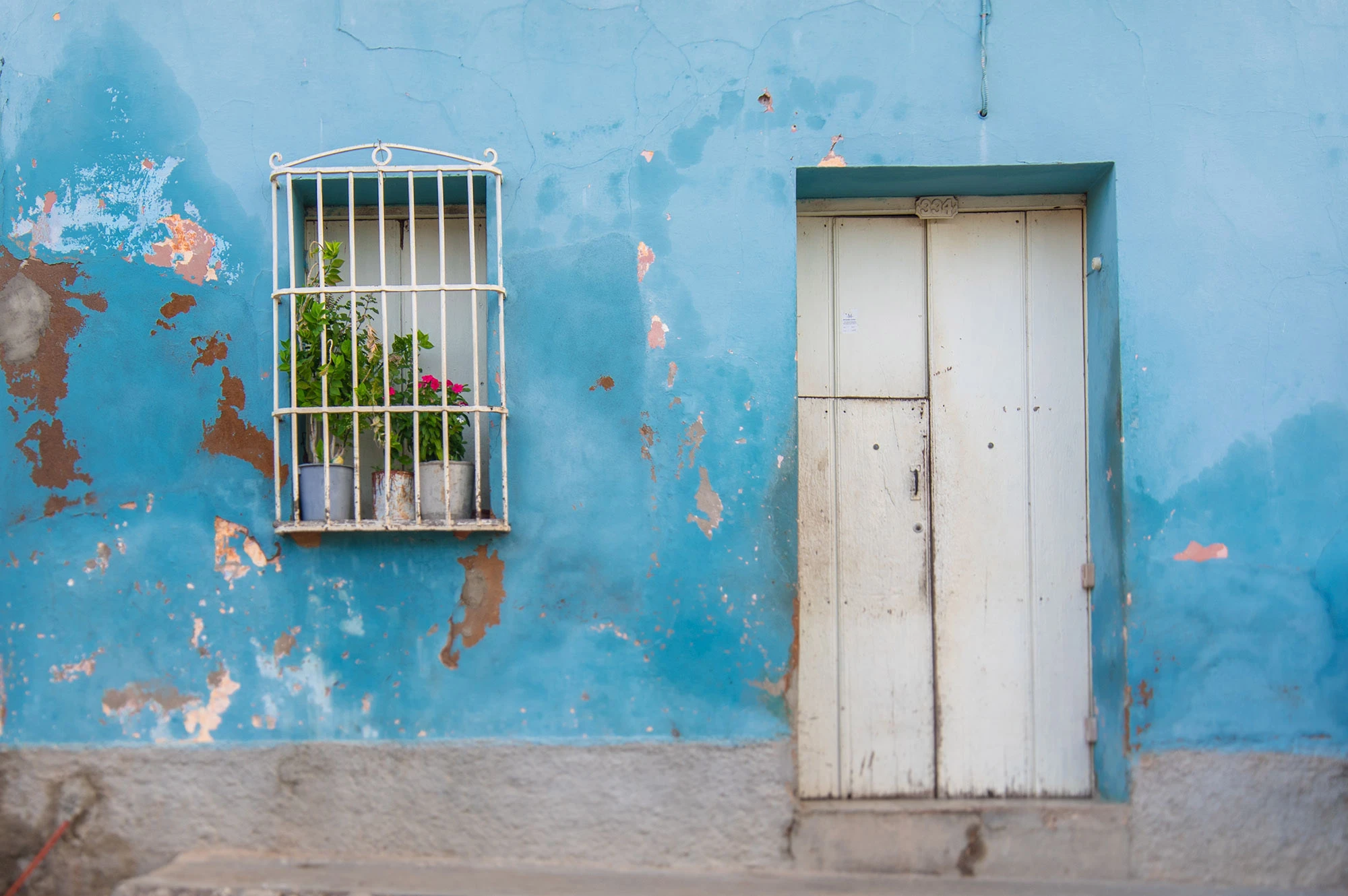
Typical wrought-iron window in residential Trinidad.
I am inspired by my conversation with Ali, who encourages me to think more about the idea of Cuba following in the footsteps of Costa Rica as a path out of its isolated, communist past. In so many parallels, Cuba has the perfect foundation for developing a rich, vibrant tourism sector that attracts high-quality tourists who want to learn about culture, nature, music and the arts.
In the van ride to Trinidad, I saw a virtually undeveloped interior. Cuba is similarly protected to Costa Rica. While Costa Rica has protected twenty-five percent of its land, Cuba has protected twenty-two percent. These are impressive percentages, but why not beat Costa Rica at its own game and take advantage of all that state-owned land. Seventy-percent for Cuba, and continue to restore the nine UNESCO sites littered across the country, building an urban and protected infrastructure?
The old red Buick putters and comes to a stop at the end of the road. Ali would hang out at the cafe, Gimoaldo would wait by his steed, and I would wander off into the jungle. Having given up on my pedorrera, I want to look for a few more Cuban species - birds, butterflies, lizards.
The forest trail is hot, and I am already weary from my long morning. On a steep cliffside trail, I catch my breath by setting up the tripod and leaning over it. I wearily look out over the valley, waiting for signs of life.
I hear this quick, vibrating sound. It had just buzzed right past my ear. I instantly recognize that sound as the sound of large hummingbirds in South America. It’s the sound of energy and speed in a small package, like a tiny drone on a full battery.
I do a quick calculation. The Cuban Emerald hummingbird is too small for that sound, and the Bee Hummingbird, smallest bird in the world, would be even less likely a candidate. Large insect? No, too powerful. One of those large flying beetles? No, not in Cuba. Time to wake up!
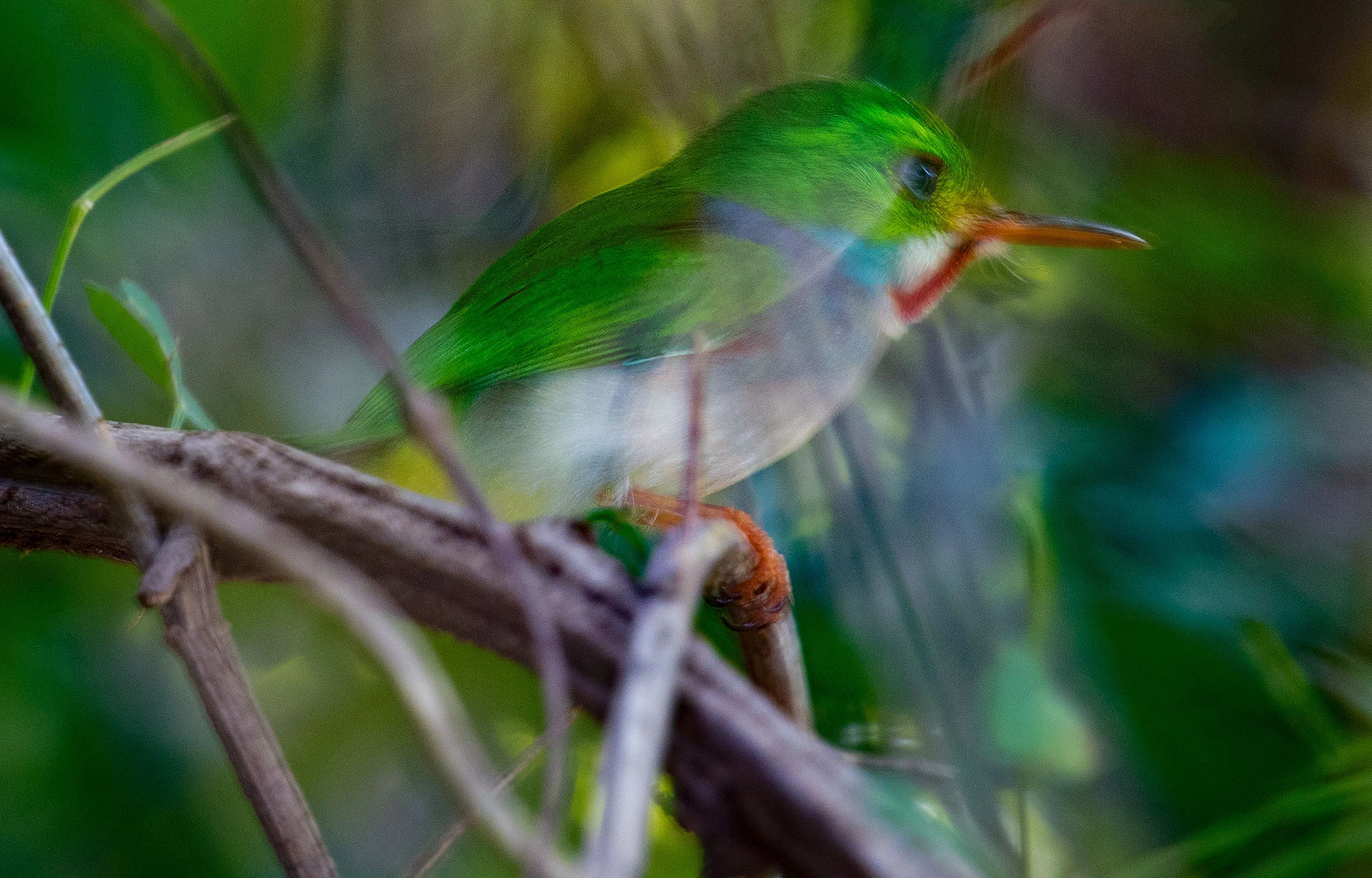
The Pedorrera (Little Farter), the bite-sized Cuban Tody
I turn around and sitting on a branch just five feet away from me is Cuba’s Little Farter; the pedorrera. The Cuban Tody!
It is so much smaller than I imagined. The size of a hummingbird! In this dark cliffside forest, it gleams with bright coloration. Impossibly beautiful color! A Psychedelic flyer! Emerald green body, a brilliant blue eye. Throat firey red, flanks hot pink, its collar both cyan and violet. Acid yellow on its breast! It’s staring at me curiously, bobbing gently up and down on a twig. I fire off two pictures, and then, in a burst of sound, like a long sputtering fart, it is gone.
